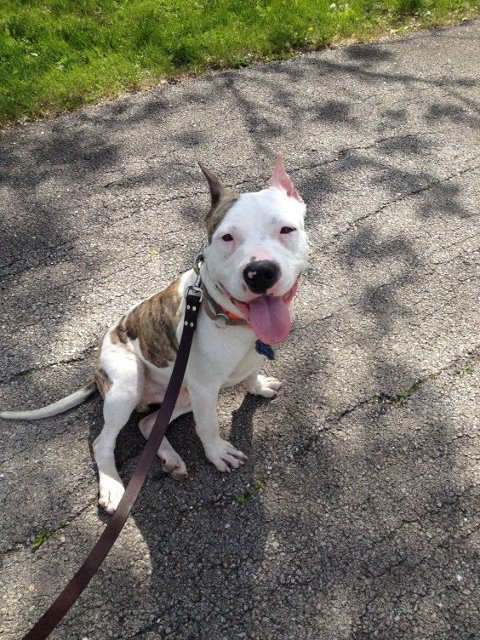Before I get to today's blog topic, I have decided to start including the photo and bio of an adoptable pet with each blog. This week's pet is "Lil Leroy," available for rescue with Safe Humane Chicago.

Lil Leroy was brought to Chicago Animal Care and Control after his defendant owner decided to give him up rather than have him neutered, but his charming good looks and artful personality won his foster mom over.
Leroy adores people. He likes other dogs too, but people really take the cake. Because he likes people so much, his ideal home will have an adult, well-balanced, dominant dog. Male or female -- makes no difference. He just needs a big bro or sis to show him the ropes. He also lives with two dog-savvy cats! Leroy's Forever People will need to be patient as I slowly learn the ropes and figure out what it means to be a dog but that's really all he needs. Well, that along with food and cuddle time, of course. He's house broken, crate trained and is learning leash manners. For more information on Lil Leroy, visit www.safehumanechicago.org.
And now, on to my blog. Many times a day I hear the following question from my clients: What is the best food to feed my cat? My answer is always dependent on the age, body condition and health of the cat. However, for the average adult healthy cat, I recommend a canned diet with the following composition -- greater than 50 percent of the calories ingested should be from protein, less than 10 percent daily calories from carbohydrates, and at least 30 percent of their daily calories from fat.
Why would I make this recommendation? It is for the following reasons.
Cats are obligate carnivores. They are designed to eat meat, not plants. An ideal diet for a cat would be five-to-six mice per day -- for your information, mice are high in protein (48 percent), low in carbohydrates (5 percent) and approximately 48 kcal per mouse. Unlike omnivores, cats are unable to process and store carbohydrates well. Cats fed high carbohydrate diets have higher blood glucose levels compared to cats fed low carbohydrate diets due to their failure to convert excess glucose to glycogen (storage form of energy). Many cats recently diagnosed with Diabetes Mellitus are placed on a high protein, low carbohydrate diet (like the diet composition I recommended above) and their diabetes has gone into remission. These cats no longer need insulin. In addition, it has been speculated that cats fed high carbohydrate diets may have a have a higher incidence of gastrointestinal disease (Inflammatory Bowel Disease) due to their poor management of carbohydrates ingested and resultant bacterial overgrowth in their gastrointestinal tract.
Not only is it important to check the pet food label to see the quantity of protein in the can but also look at where the protein is coming from. Cats have a fairly simple digestive tract and lack the ability to synthesize certain amino acids from their diet. There are four amino acids (taurine, arginine, methionine and cysteine) that must be provided in their diet and are best found in animal proteins, not plant proteins. In addition, given their relatively short gastrointestinal tract, they have a dramatically reduced ability to extract nutrients from plant material. The biological value (how well the pet absorbs and utilizes the ingredient) of animal protein (like beef or chicken meat) is almost twice that of a plant protein (like corn, gluten meal or soybean meal) for cats. So when selecting an ideal diet for your cat, choose a diet that is primarily meat-based protein and not grain-based protein rich diet.
Additionally, cats have deficient amounts of digestive enzymes necessary to process raw vegetables and fruit into an efficient usable energy source or biologically active form. Many people have very strong positive feelings about feeding delicious fruits (like blueberries) and vegetables (like carrots) to their pets. However, it is species inappropriate to feed vegetables to an obligate carnivore (your cat). Some people may argue that your cat may consume plants in the wild. The amount of plants a cat eats in the wild is minuscule compared to the amount of plant-based ingredients found in the average commercial cat food. Some people may argue that cat's kill their prey and eat their intestines that contain plant material. Yes, your wild cat may eat a mouse that has ingested some plants. However, their argument does not take into account that the vegetable matter in the prey (for example, this mouse) is pre-digested by the mouse's own enzymes and not by the cat.
I know this point may ignite some controversy amongst my readers, but I'm a strong advocate against raw diets. I do not recommend feeding cats raw meat for the following reasons: high risk for parasitism, bacterial infections and ingestion of toxins. My 14-year-old son's science project last year was on the bacterial content of raw chicken and hamburger purchased at a high end food store versus a moderate priced grocery store. As I predicted, all raw meats grew a significant amount of potentially harmful bacteria. Guess which raw products grew the most bacteria? The high-end store's products! High price and organically fed cows and chickens do not guarantee bacterial-free, safe products.
In support of feeding commercially prepared raw meat diets to their cats, some of my clients say, "That's what they eat in the wild." I counter argue, "Yes, they eat raw meat in the wild that is killed and eaten immediately. It is not killed at a slaughterhouse, shipped to a processing plant, handled by dozens of workers in conditions that may be less than ideal (recall the recent Diamond Food Manufacturing Plant food violations) and then, sent to a grocery store where it may be days before it is consumed." It's just not the same. In addition, cats in the wild live only a few years, whereas cats in our home may live 15 to 20 years. A big difference!
Lastly, why would I ever recommend opening a stinky can of cat food twice daily? Well, cats evolved in the dessert and regrettably have a low thirst drive. As a result of this low thirst drive, a cat fed a dry food diet will ingest 50 percent less water than a cat fed canned food. In the wild, cats consume mice that are made of approximately 70 percent water. Most canned foods contain at least 75 percent water compared to dry foods which are about 10 percent water. Cats who are predisposed to forming crystals in their urine benefit greatly from ingesting canned diets. Higher water intake equates to more dilute urine and lower incidence of crystal formation in urine. In addition, cats fed canned food have a lower incidence of hyperthyroidism, diabetes, constipation, obesity and helps keep cats hydrated with kidney disease.
In conclusion, remember that natural ingredients may be healthy for you, but may not be nutritious for your pet. The key to choosing a good diet for your cat is to choose a diet that mimics the nutritional composition of their natural diet.
Although our understanding of feline nutrition may be at it's infancy stage today, I recommend feeding an animal-based protein rich canned food to your beloved cat for maximum longevity and good health. Bon appetite!
